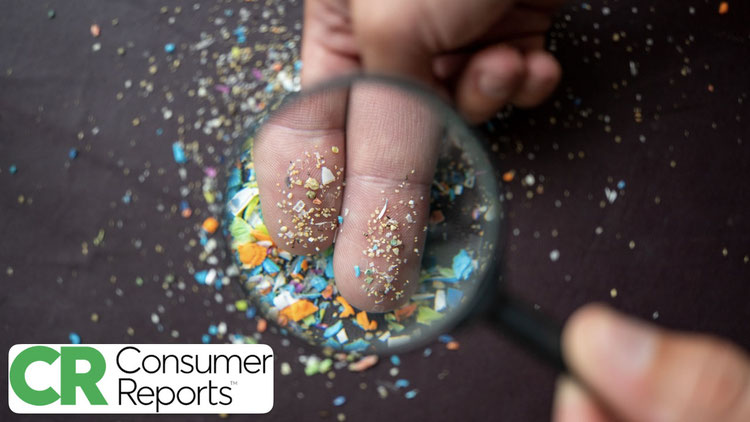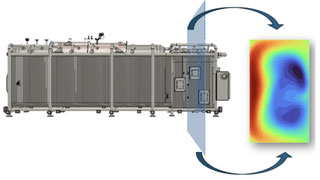The objective of this Challenge is to generate ideas for methods of microplastic detection in food that can be transformed into simple and inexpensive tests performed by consumers at home.
Consumer Reports (CR), the Sponsor of this Challenge, is an independent nonprofit with more than 6 million members who fight with their voices and choices for a fair and just marketplace—one that is responsive and resilient enough to deliver trust to consumers no matter what changes come their way. CR empowers and informs consumers, incentivizes corporations to act responsibly, and helps policymakers prioritize the rights and interests of consumers in order to shape a truly consumer-driven marketplace.
Background
Over the past few years, microplastics—defined as plastic fragments smaller than 5 millimeters in size—have emerged as an environmental concern that has captured the attention of scientists, policymakers, and the public at large.
It is customary to characterize microplastics into two major types: primary and secondary. Primary microplastics are those that are intentionally manufactured to be small for specific applications. Examples include microbeads in cosmetic products and plastic pellets used in manufacturing processes. Secondary microplastics are the result of the degradation of larger plastic items through mechanical wear and weathering. Common sources of secondary microplastics include broken-down plastic bottles and bags.
The interest in microplastics has surged due to their pervasive (and seemingly growing) presence in various ecosystems, including oceans, lakes, rivers, and even remote locations such as Arctic ice. Although the precise amount of microplastics in the environment is difficult to estimate, this number is likely to be rising in parallel with the increased production of industrial and consumer plastics. Exacerbating the potential threat of microplastics to the environment is the fact that, unlike many other organic materials, plastics do not biodegrade easily and can therefore remain intact for years.
The precise environmental impact of microplastics is a topic of extensive debate. A consensus seems to be emerging that microplastics may impact marine environments by reducing the feeding efficiency of marine organisms and therefore leading to increased mortality rates among species that ingest microplastics. The ecological consequences may extend beyond individual marine species: entire food networks can be disrupted as accumulated microplastics travel up the food chain, eventually reaching humans through seafood consumption.
The implications of microplastic exposure on human health are less clear. Numerous studies point to potential risks associated with ingestion and inhalation of microplastics. These risks are greatly exacerbated by the fact that microplastics can be contaminated with heavy metals (for example, lead and arsenic) and can also carry toxic chemical compounds (for example, bisphenols and phthalates) that can migrate into food from plastic food packaging. Moreover, it was shown that microplastics can cross biological barriers of the body and accumulate in various organs, including the liver, lungs, and the brain. The potential effects of this accumulation on reproductive health and the incidence of cancer and respiratory and cardiovascular diseases are being investigated.
The Problem
It is essential to state again that while there is a growing concern about the effects of microplastics on the environment and human health, understanding of the extent of their harm remains limited. Reflecting this fact, The World Health Organization emphasizes that more comprehensive research is needed to fully understand how microplastics affect human health. Obviously, at the core of this approach lies the ability to closely monitor the distribution of microplastics, their movement in food chains, and the points of entering the human habitat.
Unfortunately, hampering this ability is the lack of simple methods of detecting microplastic in different milieus including food. Most of the currently available protocols are based on complex techniques, such as Raman spectroscopy, FTIR microspectroscopy, and Scanning Electron Microscopy analysis. While capable of detecting microplastic particles of various sizes and at low concentrations, these tests can be conducted only in specialized testing labs. They also take a long time to conduct (up to 4-6 weeks) and are expensive: up to $150-250 per sample.
The Challenge
To ensure that the detection of microplastics in the environment could take place on a massive scale—so that consumers had a better understanding of the sources of microplastics that enter their bodies—there is an urgent need to develop simple and inexpensive tests that consumers could perform themselves without special training, similar to administering at-home over-the-counter COVID-19 diagnostic tests.
The objective of this Challenge is therefore to generate ideas for methods of microplastic detection in food that could be eventually transformed into simple and inexpensive tests performed by consumers at home.
We anticipate that these ideas are based on solid research data that can be converted into commercially available at-home tests within 1-2 years.
We also anticipate that the proposed methods will be applicable to a broad range of foods, including liquid foods (milk, beverages, etc.), semi-solid foods (eggs, pastes, etc.), and solid foods (fruits, vegetables, meat, poultry, etc.). Of special interest to us is the ultra-processed food, which by itself is linked to an increased risk of obesity, type 2 diabetes, and heart disease.
We assume that the proposed tests that are applicable to liquid foods could also be used to detect microplastics in drinking water. The participants in this Challenge may therefore find inspiration in the design of a recently described low-cost test that can detect and measure micro-, and even tinier nanoplastics, in water. Participants can also take inspiration from the methodology underpinning easily available home tests like pregnancy or COVID-19 tests.
Obviously, the future at-home tests can’t be as sensitive as the current lab tests. Further, there might be different testing methodologies for different sizes of microplastics. As such, we’re therefore willing to accept ideas for the tests that would be only sensitive enough to allow reliable detection of microplastics in the close proximity to the consumers. More specifically, we expect the proposed tests to be able to detect various types of microplastics of at least 5-10 micrometers in size and at concentrations equivalent to 500 particles per liter of a liquid substance.
Finally, we anticipate the proposed at-home tests being fast—with the results being available within 2 hours—and non-expensive, with the cost of one sample testing not exceeding $15.
Success Criteria
To summarize, the proposed methods for at-home detection of microplastics in food should meet the following requirements:
- The proposed methods should be applicable to a broad range of foods, including liquid foods (milk, beverages, etc.), semi-solid foods (eggs, pastes, etc.), and solid foods (fruits, vegetables, meat, poultry, etc.).
- The proposed methods should be able to detect various types of microplastics of at least 5-10 micrometers in size.
- The proposed methods should be able to detect various types of microplastics at concentrations not exceeding the equivalent of 500 particles per liter of a liquid substance.
- The proposed methods should be fast—with the results being available within 2 hours.
- The proposed methods should be non-expensive, with the cost of creating one sample test not exceeding $15.
- The proposed methods should have the potential to be transformed into commercially available at-home tests within 1-2 years.
We fully expect the proposed methods to be solidly based on sound scientific research; we will therefore not accept proposals that do not provide thorough justification of the proposed approaches supported by published articles, patents (or patent applications), research notes, etc.
We also want to emphasize that our ultimate objective is the development of at-home tests for microplastic detection. We’re therefore not interested in approaches that require specialized equipment, reagents, or extensive professional training.
Every successful submission to this Challenge will be formatted as a 10-15-page report with a one-page Executive Summary. Again, we expect these reports to be solidly research-based, with all the statements supported by published precedents and properly referenced.
The submitted proposals will be evaluated and judged based on the following three criteria (listed in the order of their importance, the transformability to at-home tests being the most important):
- The potential for the test to be eventually transformed into a simple at-home test that consumers may perform themselves without special training. The proposals that promise the most direct route to such a conversion will be given special attention.
- The sensitivity of the proposed test, that is, its potential to detect various types of microplastics of at least 5-10 micrometers in size and at concentrations not exceeding the equivalent of 500 particles per liter of a liquid substance.
- The potential cost of the proposed method.
We envision that up to three (3) awards will be given to the proposals that best meet the Challenge Requirements. The following amounts will be awarded to each winner:
- 1st Prize: $5,000
- Two (2) Runners-Up: $2,500 each
We encourage the Challenge participants to use LLM algorithms for data collection and its preliminary analysis. However, we expect the participants to make sure that everything proposed by an LLM algorithm is properly vetted, verified, is placed in proper context by the participant. Submissions produced solely by generative AI will be discarded.
 Resubmitting?
Resubmitting? Quick Submission Reminders:
Quick Submission Reminders:










